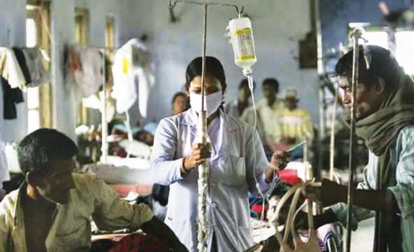TB drug resistance signifies failure
Multi-drug
resistant and extensively drug resistant tuberculosis are exposing the
inadequacies of TB control programs.
Tuberculosis control programs are among the oldest public health
campaigns (dating back 125 years) but are not nearly as successful as
they should be. Despite effective drugs having been available for over
50 years, TB still kills a million people a year, making it the world's
single deadliest infectious disease after AIDS. When those who work in
the field of TB want to be cheerful they stress that TB is no longer the
killer that it used to be; there has been a drop in mortality of 45
percent in the past 25 years. But in reality that is not very good. It
is certainly nowhere near good enough to meet the World Health
Organization's (WHO) own target - to reduce by 2035 the incidence of the
disease to the kind of levels seen, for instance, in North America.
"It's not going to happen," admits Suvanand Sahu, deputy executive
secretary of the Stop TB Partnership, "not in our lifetime nor in our
children's lifetime. Business as usual will not get us there."
|

Patients treated at a tuberculosis hospital |
Even more discouragingly, it is by no means clear that the 45 percent
reduction is the result of national and international TB control
programs. TB had already ceased to be a threat in most of Europe and
North America by the 1960s, before the development of effective drugs.
When people are better housed, better fed, and generally enjoy a more
satisfactory standard of living, TB tends to fade away. A new report by
the Economist Intelligence Unit (EIU) points out that the reduction in
TB correlates far more closely with a country's score on the Human
Development Index than it does with the intensity of the effort it puts
into disease control.
The report puts its finger on what it calls a lack of focus by those
working on the disease. Part of the problem, it says, is a tendency to
think of TB as a kind of "background noise", something which is always
there and attracts no particular sense of urgency. There has also been a
failure to understand the way in which the disease is concentrated in
certain vulnerable populations, and to act accordingly. Encouraging
national figures for the incidence of TB can conceal pockets of much
higher infection rates. David Moore, professor of infectious diseases at
the London School of Hygiene and Tropical Medicine, told a meeting in
London to launch the report that even the UK's own low national rates
conceal much higher levels in the capital. "And even within London,
rates are not uniform," he told his listeners. "There are some boroughs
of London where the incidence of TB is between 70 and 150 per 100,000 of
the population per year, which is about the rate of TB in Sudan."
It is estimated that a third of cases of active TB are never
diagnosed or treated. A pioneering "cough monitor" project in Kenya's
Rift Valley, where rates are high, has been testing around 2,000 people
a year: 16 percent tested positive for TB. Using village health workers
in Ethiopia to test people with persistent coughs doubled the detection
rate for the disease.
Detection rates among children are even lower. Their disease is
harder to diagnose by the most common testing methods, and workers with
a public health focus tend to overlook children, assuming that they are
less likely to be a source of infection. Scientists at the University of
Sheffield have done some complicated analysis of the data, and reckon
that high-burden countries only detect one third of the children with
active TB.
Their report suggests that childhood TB could be greatly reduced if
you gave preventative therapy with isoniazid, one of the most basic of
TB drugs, to all children under the age of 15 who are living with an
actively infectious patient (an estimated 15 million children
worldwide).
"With TB, if you don't keep a lid on it, it will come back and it
will come back hard." The lead author, Peter Dodd, says getting good
figures is also important in its own right.
"Quantifying the burden of TB in children is important," he says,
"because without good numbers, there can be no targets for improvement,
no monitoring of trends and there is a lack of evidence to encourage
industry to invest in developing medicines or diagnostics that are more
appropriate for children than those available today."
TB is not an easy disease to treat, and is unforgiving of mistakes.
Courses of treatment are long and many of the drugs have side effects.
Because of this, because they move away or because the drugs are not
always available, patients often fail to complete their treatment.
According to the author of the EIU report, Paul Kielstra, "with any
infectious disease, if you make some progress but not a lot of progress,
the disease will fight back. With TB, if you don't keep a lid on it, it
will come back and it will come back hard." Now multi-drug resistant (MDR)
and extensively drug resistant (XDR) tuberculosis are ruthlessly
exposing the inadequacies of TB control programs.
"Every single one of those cases," says Moore, "is the story of a
failure somewhere along the line." Some patients with MDRTB find that
their disease has become resistant to basic drugs because of failures in
treatment. A far greater number contract MDRTB directly from someone who
has the resistant strain but where this has not been identified, so that
he or she is not recovering and is still walking round infecting others.
Most of the EIU's recommendations are about using existing tools and
systems more effectively. After all, despite the spread of resistant
strains, 85 percent of TB cases are still curable with basic, first line
drugs.
- Third World Network Features.
|

